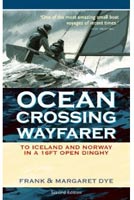 Frank Dye was a small boat cruiser who became something of a legend following his sea voyages in his 16′ Wayfarer open dinghy.
Frank Dye was a small boat cruiser who became something of a legend following his sea voyages in his 16′ Wayfarer open dinghy.
Frank Dye, who died on May 16 aged 82, was a cult figure among small-boat sailors for undertaking numerous voyages in his open 15ft 10in wooden Wayfarer dinghy Wanderer; these included passages from Scotland to Iceland and across the North Sea to Norway, and featured mountainous seas, gales up to Force 11 and numerous capsizes and broken masts.
Dye made his most famous voyages in the early Sixties. During his 11-day, 650-mile North Atlantic crossing from Scotland to Iceland, armed with just a compass and sextant for navigation and with a makeshift cockpit tent for shelter, he and his one-man crew, Russell Brockbank, endured seasickness, sodden clothing, Force 8 gales, freezing temperatures and broken rigging before they made landfall on the Icelandic island of Heimay.
Dye’s Norfolk-built Wayfarer logged tens of thousands of miles and took him across the North Atlantic and further afield. In 1988, sailing single-handedly, he survived a hurricane off the United States as Force 11 seas battered his tiny craft. In Sailing to the Edge of Fear (1999) he recalled his near-death experience as the genoa sheet jammed and the boat hurtled down cresting seas at 20 knots (the theoretical hull speed of a 16ft dinghy is about 5.5 knots), while he struggled to free the sheet and lower the sail.
“Offshore cruising in an open boat can be hard, cold, wet, lonely and occasionally miserable,” Dye reflected, “but it is exhilarating too. To see the beauty of dawn creep across the ever restless and dangerous ocean; to make a safe landfall – is wonderful and all of these things develop a self-reliance that is missing from the modern, mechanical, safety-conscious civilised world.”
Dye wrote in 1999: “People talk about respect for the sea, but respect is based on fear. While fascination outweighs the fear I sail on. When the balance changes, it’s time to stop.”
